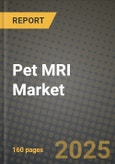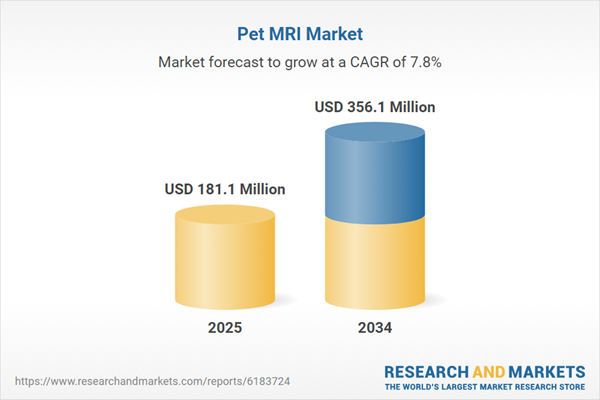Pet MRI Market
The PET/MRI market (hybrid positron emission tomography with magnetic resonance imaging) comprises integrated scanners, coils, digital PET detectors, radiopharmaceuticals, and software workflows enabling simultaneous molecular and high-contrast anatomical/functional imaging. Top applications include neuro-oncology and neurodegeneration (tumor delineation, treatment response, amyloid/tau imaging), pediatric and young-adult oncology (dose-sparing vs. PET/CT), head & neck staging, pelvic cancers (notably prostate with PSMA ligands), cardiology viability/inflammation, and research in immuno-oncology and inflammation. Recent trends emphasize digital SiPM detector blocks with time-of-flight capabilities, advanced MR-based attenuation correction (including UTE/ZTE bone mapping), motion correction and respiratory gating, AI-accelerated reconstruction/denoising, whole-body protocols with shortened table times, and theranostic care pathways linking PET/MRI phenotyping to radionuclide therapy. Growth drivers include demand for radiation-sparing imaging, sharper soft-tissue contrast in complex regions, multimodal biomarkers for precision therapy, and academic-industry consortia validating clinical utility. The competitive landscape features diversified imaging majors and emerging entrants competing on detector sensitivity, gradient performance, workflow orchestration, and service models spanning radiopharmacy logistics and protocol libraries. Differentiation increasingly comes from end-to-end ecosystems - radiotracer access, coils, AI toolkits, and oncology/cardiac protocols - plus uptime guarantees and training. Barriers remain high: capital and lifecycle cost, siting and shielding complexity, technologist cross-training, longer exam times vs. PET/CT, heterogeneous reimbursement, and radiotracer availability. Overall, PET/MRI is shifting from niche research to targeted clinical adoption where soft-tissue delineation, dose stewardship, and simultaneous multiparametric insights provide clear outcome and workflow advantages.Pet MRI Market Key Insights
- Clinical sweet spots solidify: Neuro-oncology, head & neck, and prostate cancer show the strongest clinical rationale - leveraging MR’s soft-tissue contrast and multiparametrics with PET’s sensitivity to guide surgery, radiation, and systemic therapy.
- Radiation stewardship drives pediatrics: Dose reduction vs. PET/CT underpins pediatric oncology use; optimized protocols and faster sequences expand throughput while maintaining diagnostic confidence for longitudinal follow-up.
- Digital PET + TOF improves SNR: SiPM detectors and time-of-flight timing resolution enhance lesion detectability at lower tracer doses; deep-learning reconstruction further improves image quality and reduces scan time.
- MRAC and motion are make-or-break: Reliable bone/air modeling (UTE/ZTE), continuous table motion, and AI motion correction reduce artifacts and quantitation error - critical for therapy planning and response assessment.
- Theranostics lifts relevance: PET/MRI supports selection and monitoring for radioligand therapies (e.g., PSMA, SSTR), correlating molecular uptake with MR diffusion/perfusion to personalize dosing and timing.
- Cardiac and inflammation emerge: Simultaneous perfusion/viability/inflammation imaging with PET tracers and MR mapping (T1/T2/LGE) informs myocarditis and sarcoidosis care, broadening non-oncology use cases.
- Workflow orchestration differentiates: Auto-prescription of sequences, one-click protocols, and integrated QA reduce operator burden; vendors that bundle coils, positioning aids, and standardized reporting win hospital committees.
- Economics hinge on multi-service demand: Sites justify ROI via mixed caseloads (neuro, prostate, pediatrics, research), extended hours, and partnerships with radiopharmacy networks to stabilize tracer supply and uptime.
- Training ecosystems matter: Cross-training for PET and MRI technologists, physicist support, and remote protocol optimization improve consistency and reduce repeat scans - key in multi-site health systems.
- Evidence base expands: Prospective trials and real-world registries quantify incremental value vs. PET/CT or MRI alone, focusing on management changes, reduced additional scans, and dose/time trade-offs.
Pet MRI Market Reginal Analysis
North America
Adoption concentrates in academic medical centers, pediatric hospitals, and high-volume oncology networks. Programs emphasize prostate and neuro-oncology, with growing interest in cardiac inflammation and immuno-oncology monitoring. Reimbursement remains variable, pushing sites to blend clinical and research throughput. Partnerships with radiopharmacies and vendor service SLAs are pivotal for tracer availability and uptime; AI-assisted reconstruction helps trim exam times.Europe
Strong HTA culture and centers of excellence advance standardized protocols, particularly in neuro-oncology and head & neck. Multinational research consortia evaluate outcome and cost-utility endpoints, guiding national procurement. Emphasis on dose stewardship and MR-based functional mapping aligns with pediatric and pelvic oncology use. Tendering favors integrated service packages, training, and lifecycle support with energy-efficient system designs.Asia-Pacific
Installations expand in Japan, South Korea, China, Australia, and India across flagship cancer hospitals and research institutes. Pelvic oncology (PSMA) and neuro indications lead, with growing pediatric adoption. Domestic radiopharmacy capacity and local manufacturing improve tracer access and cost control. Buyers prioritize price-performance, rapid service response, and scalable protocols; government grants often underwrite early clinical research.Middle East & Africa
Gulf medical cities and select academic hubs invest in PET/MRI to anchor comprehensive cancer and cardiac programs. Procurement stresses turnkey delivery - site planning, training, and tracer logistics. Case mixes emphasize head & neck, pelvic, and pediatric oncology, with rising cardiac inflammation evaluations. Broader regional diffusion is gradual, paced by reimbursement and radiopharmacy infrastructure.South & Central America
Major urban cancer centers and private hospital networks lead adoption, focusing on neuro and prostate imaging. Currency and import dynamics heighten attention to total cost of ownership, uptime guarantees, and multi-year service coverage. Tracer supply agreements and shared-use models (research + clinical) support viability. Training partnerships and standardized protocols help ensure consistent image quality and reporting across networks.Pet MRI Market Segmentation
By Product
- Integrated
- Separate
- Insert
- Hybrid
By Imaging Technology
- Conventional
- Time of Flight
By Image Acquisition
- Sequential PET MRI Scanners
- Simultaneous PET MRI Scanners
By Application
- Pre-clinical PET MRI Systems
- Clinical PET MRI Systems
By End-User
- Hospitals
- Diagnostic Laboratories
- Research Institutes
- Pharmaceutical & Biopharmaceutical Companies
Key Market players
Siemens Healthineers AG, GE Healthcare, Koninklijke Philips N.V., Bruker Corporation, Mediso Ltd., MR Solutions Ltd., Cubresa Inc., Aspect Imaging Ltd., United Imaging Healthcare Co., Ltd., Inviscan SASPet MRI Market Analytics
The report employs rigorous tools, including Porter’s Five Forces, value chain mapping, and scenario-based modelling, to assess supply-demand dynamics. Cross-sector influences from parent, derived, and substitute markets are evaluated to identify risks and opportunities. Trade and pricing analytics provide an up-to-date view of international flows, including leading exporters, importers, and regional price trends.Macroeconomic indicators, policy frameworks such as carbon pricing and energy security strategies, and evolving consumer behaviour are considered in forecasting scenarios. Recent deal flows, partnerships, and technology innovations are incorporated to assess their impact on future market performance.
Pet MRI Market Competitive Intelligence
The competitive landscape is mapped through proprietary frameworks, profiling leading companies with details on business models, product portfolios, financial performance, and strategic initiatives. Key developments such as mergers & acquisitions, technology collaborations, investment inflows, and regional expansions are analyzed for their competitive impact. The report also identifies emerging players and innovative startups contributing to market disruption.Regional insights highlight the most promising investment destinations, regulatory landscapes, and evolving partnerships across energy and industrial corridors.
Countries Covered
- North America - Pet MRI market data and outlook to 2034
- United States
- Canada
- Mexico
- Europe - Pet MRI market data and outlook to 2034
- Germany
- United Kingdom
- France
- Italy
- Spain
- BeNeLux
- Russia
- Sweden
- Asia-Pacific - Pet MRI market data and outlook to 2034
- China
- Japan
- India
- South Korea
- Australia
- Indonesia
- Malaysia
- Vietnam
- Middle East and Africa - Pet MRI market data and outlook to 2034
- Saudi Arabia
- South Africa
- Iran
- UAE
- Egypt
- South and Central America - Pet MRI market data and outlook to 2034
- Brazil
- Argentina
- Chile
- Peru
Research Methodology
This study combines primary inputs from industry experts across the Pet MRI value chain with secondary data from associations, government publications, trade databases, and company disclosures. Proprietary modeling techniques, including data triangulation, statistical correlation, and scenario planning, are applied to deliver reliable market sizing and forecasting.Key Questions Addressed
- What is the current and forecast market size of the Pet MRI industry at global, regional, and country levels?
- Which types, applications, and technologies present the highest growth potential?
- How are supply chains adapting to geopolitical and economic shocks?
- What role do policy frameworks, trade flows, and sustainability targets play in shaping demand?
- Who are the leading players, and how are their strategies evolving in the face of global uncertainty?
- Which regional “hotspots” and customer segments will outpace the market, and what go-to-market and partnership models best support entry and expansion?
- Where are the most investable opportunities - across technology roadmaps, sustainability-linked innovation, and M&A - and what is the best segment to invest over the next 3-5 years?
Your Key Takeaways from the Pet MRI Market Report
- Global Pet MRI market size and growth projections (CAGR), 2024-2034
- Impact of Russia-Ukraine, Israel-Palestine, and Hamas conflicts on Pet MRI trade, costs, and supply chains
- Pet MRI market size, share, and outlook across 5 regions and 27 countries, 2023-2034
- Pet MRI market size, CAGR, and market share of key products, applications, and end-user verticals, 2023-2034
- Short- and long-term Pet MRI market trends, drivers, restraints, and opportunities
- Porter’s Five Forces analysis, technological developments, and Pet MRI supply chain analysis
- Pet MRI trade analysis, Pet MRI market price analysis, and Pet MRI supply/demand dynamics
- Profiles of 5 leading companies - overview, key strategies, financials, and products
- Latest Pet MRI market news and developments
Additional Support
With the purchase of this report, you will receive:- An updated PDF report and an MS Excel data workbook containing all market tables and figures for easy analysis.
- 7-day post-sale analyst support for clarifications and in-scope supplementary data, ensuring the deliverable aligns precisely with your requirements.
- Complimentary report update to incorporate the latest available data and the impact of recent market developments.
This product will be delivered within 1-3 business days.
Table of Contents
Companies Mentioned
- Siemens Healthineers AG
- GE Healthcare
- Koninklijke Philips N.V.
- Bruker Corporation
- Mediso Ltd.
- MR Solutions Ltd.
- Cubresa Inc.
- Aspect Imaging Ltd.
- United Imaging Healthcare Co. Ltd.
- Inviscan SAS
Table Information
| Report Attribute | Details |
|---|---|
| No. of Pages | 160 |
| Published | November 2025 |
| Forecast Period | 2025 - 2034 |
| Estimated Market Value ( USD | $ 181.1 Million |
| Forecasted Market Value ( USD | $ 356.1 Million |
| Compound Annual Growth Rate | 7.8% |
| Regions Covered | Global |
| No. of Companies Mentioned | 10 |









